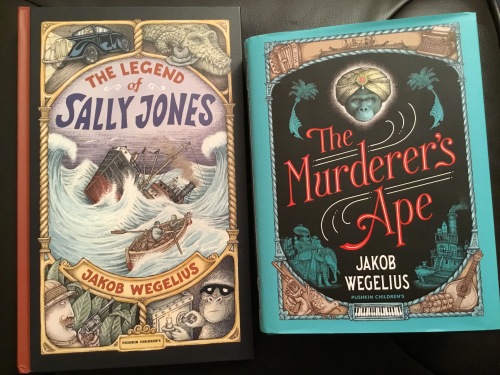
I expect published authors to spin a good yarn, but to illustrate their own books as well? Well, Wegelius, who is a freelance illustrator, has done just that. (Some people get all the gifts.) The Legend of Sally Jones is a graphic prequel to his bestselling novel The Murderer’s Ape. Both are translated from Swedish by Peter Graves, published by Pushkin Press, and winners of Sweden’s August Prize for Children’s Literature.
Now I can’t draw a straight line with a ruler and so I shall confine my critique of Wegelius’s intricate drawings to a simple I like them. Actually I like their charm a lot. The prequel is full of full-page, full-colour illustrations; the novel has half-page intricate wood-cut-like drawings at the beginning of each chapter. There are dozens to enjoy over the course of the two books, yet I do have a firm favourite.

I love the intertextual reference with its hint of what lies ahead for Sally Jones.
She is a gorilla, captured as an infant, passed and traded from human to human. She’s intelligent, understands human language (although she cannot speak) and picks up skills with no difficulty at all. She turns her hand to anything that is asked of her, and so, in the course of the prequel she becomes an international jewellery thief, a magician’s assistant and finally, a ship’s engineer. Her travels take her from the Congo to Istanbul, to Borneo. She is (mal)treated as a possession by almost every human with whom she comes into contact, but it is a fickle orangutang who breaks her heart. One human, a Finnish engineer, named Koskela, recognises her worth and a real bond develops between them over the course of these adventures. They end with the two sailing of into the sunset and onto the adventures that await in The Murderer’s Ape.
Now if The Legend of Sally Jones is a pure adventure and relationship building The Murderer’s Ape is a quest. Following a business deal gone bad, Koskela finds himself framed for murder, and Sally Jones (never just Sally) hunted by a bent copper, because she is a potential witness who must be neutralised. She finds sanctuary and a new career repairing musical instruments with the warm-hearted Ana Molina and the less keen Luigi Fidardo. Then she discovers that the man Koskela is supposed to have murdered is still alive, only he is no longer in Lisbon but far, far away in Cochin, India. And so begins the quest to find him and prove her friend’s innocence.
Pages of seafaring, shipwreck and doubledealing humanity follow. Sally Jones has to overcome extremely difficult odds and endure significant detours, At one point she is recaptured and sold to H.R.H Maharajah of Baiphur, becomes his spy in the harem, and his aircraft mechanic. However, this is a children’s book and, so it will come as no surprise, that she prevails in the end.
Wegelius doesn’t confine himself to pure adventure. Serious issues are referenced: the evils of colonialism and man’s abuse of the natural world in The Legend of Sally Jones; domestic abuse and dictatorial regimes in The Murderer’s Ape. These are dealt with in a way appropriate to the age of the books’ targeted audiences, i.e obliquely in the first book, more directly but not in graphic detail in the novel, which I think is targetted at slightly older children.
Both are utterly delightful (not all humans therein are villainous, thankfully) and there are references that will please adults that kiddies will need to grow into. I would say, at 588 pages, The Murderer’s Ape is slightly repetitive, but younger readers might not think so. I would love to share these as bedtime stories. Unfortunately there’s no-one of the right age in my life right now ….
What fun books. Love the covers! 🤠🐧